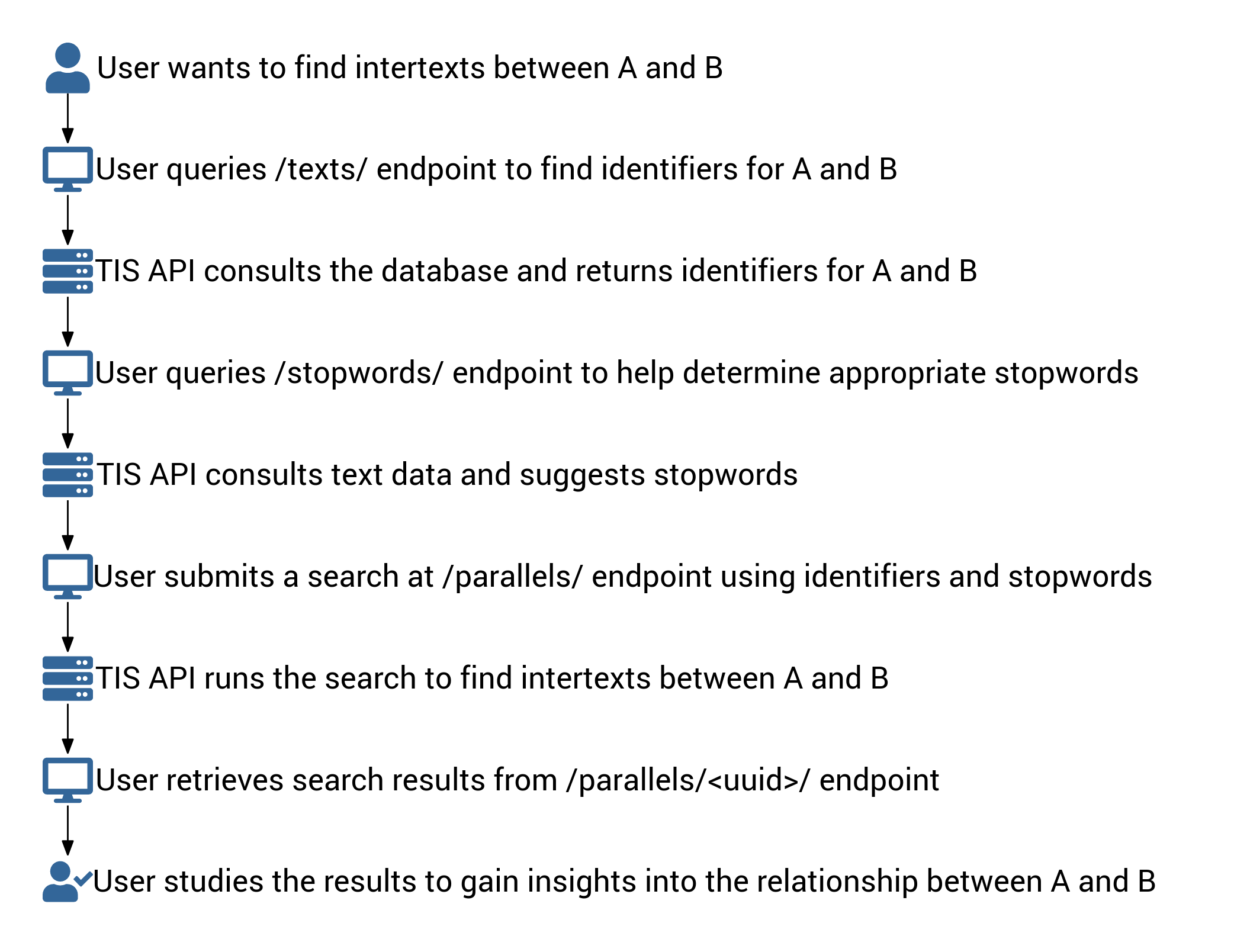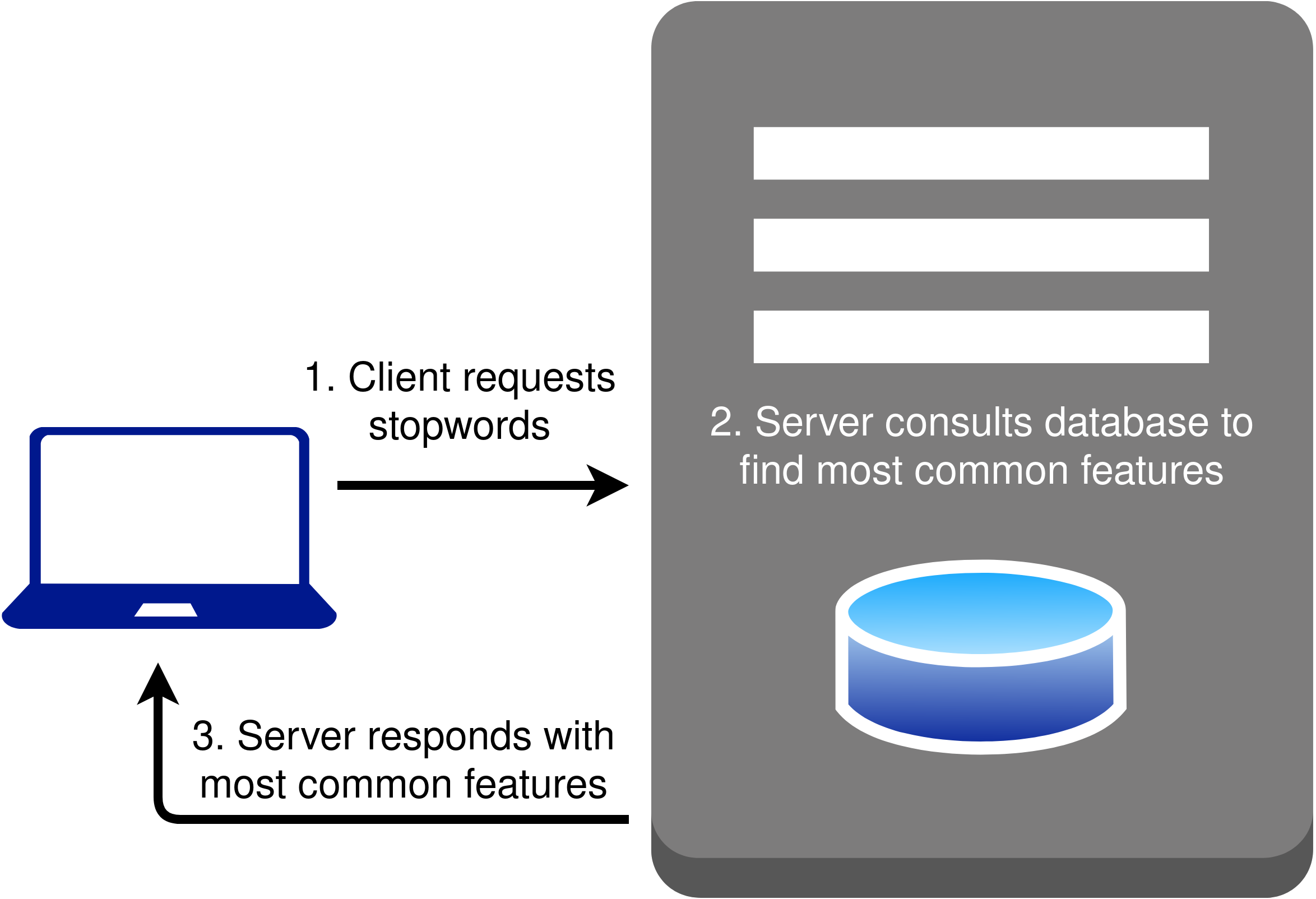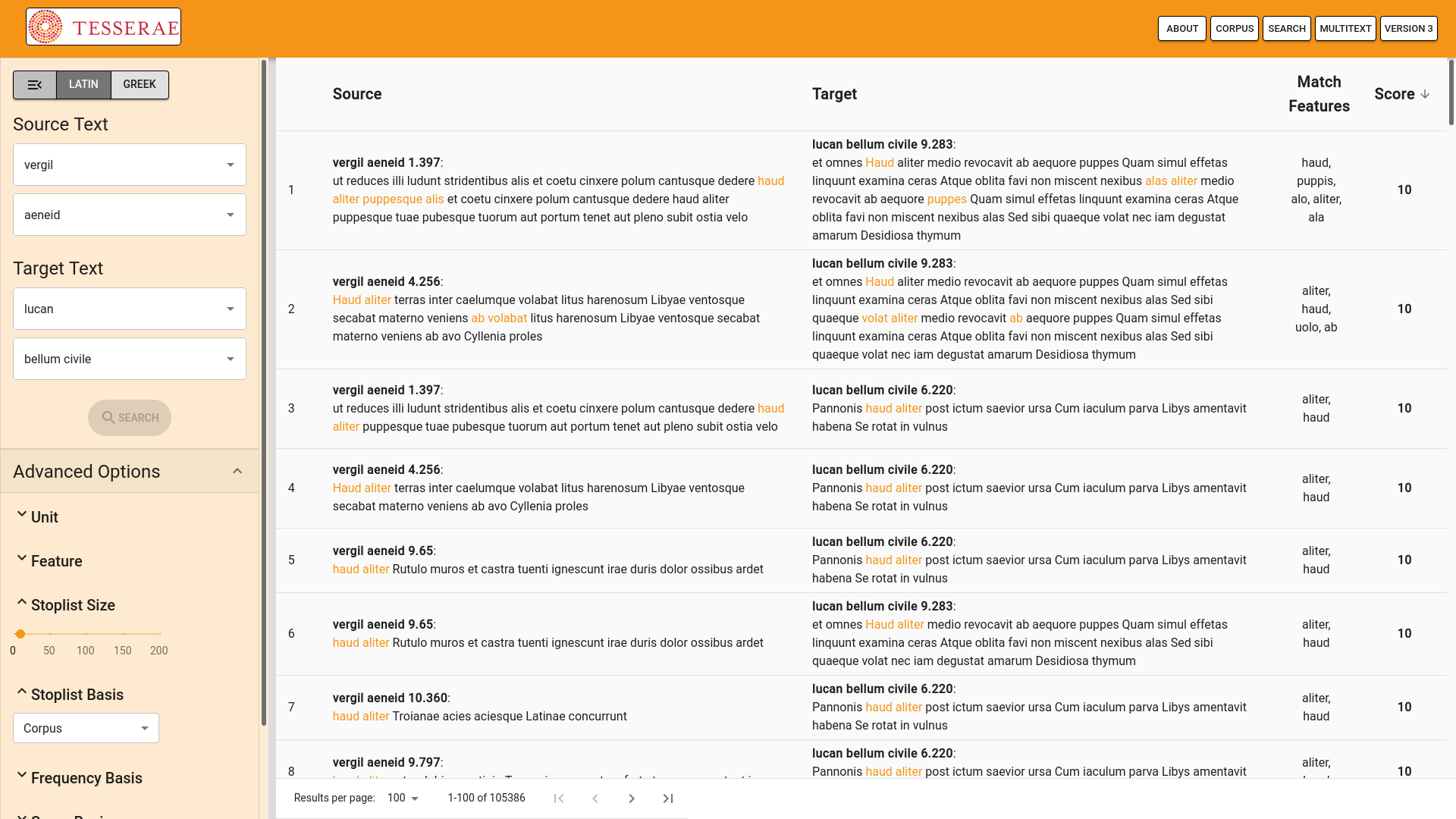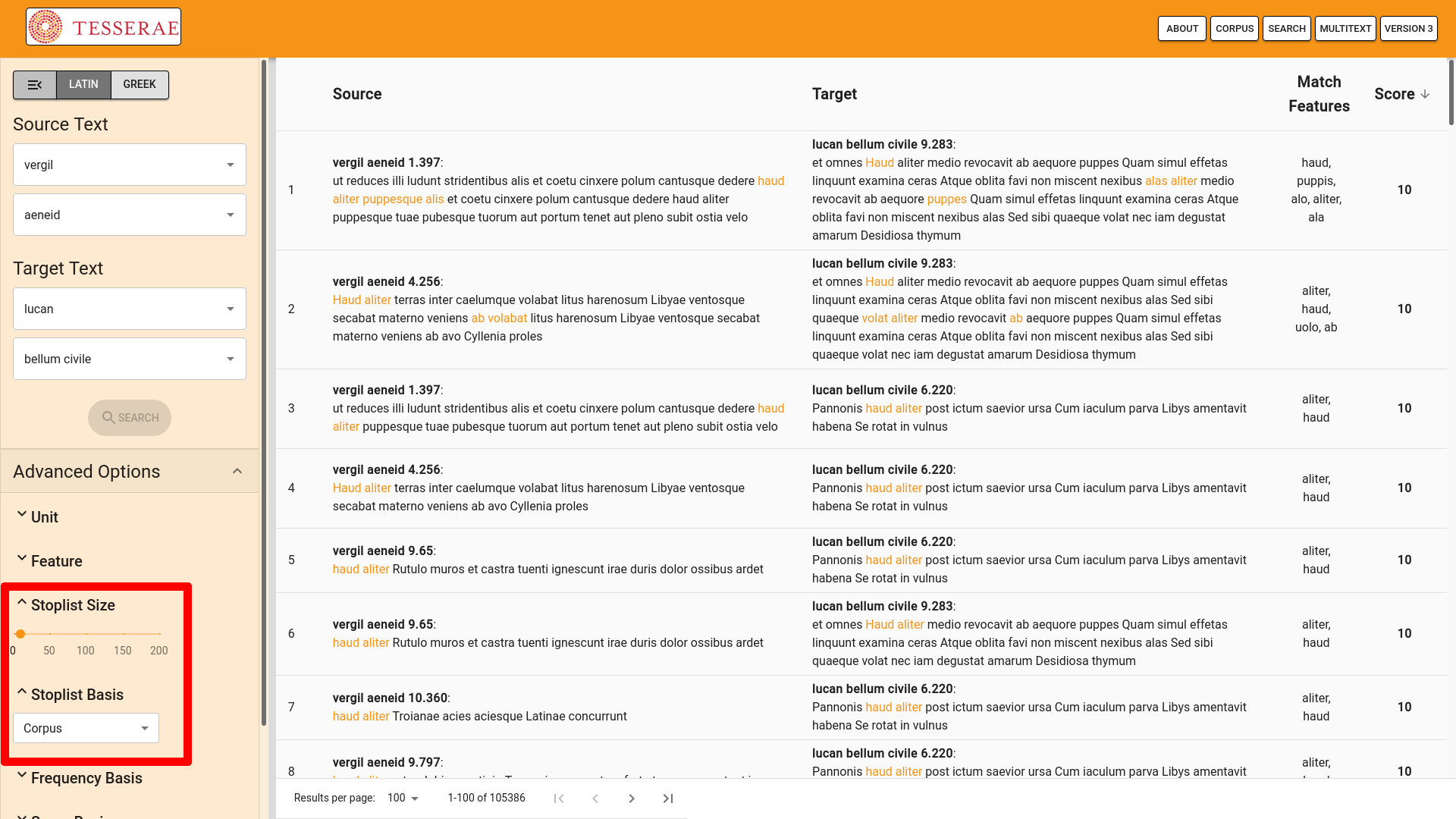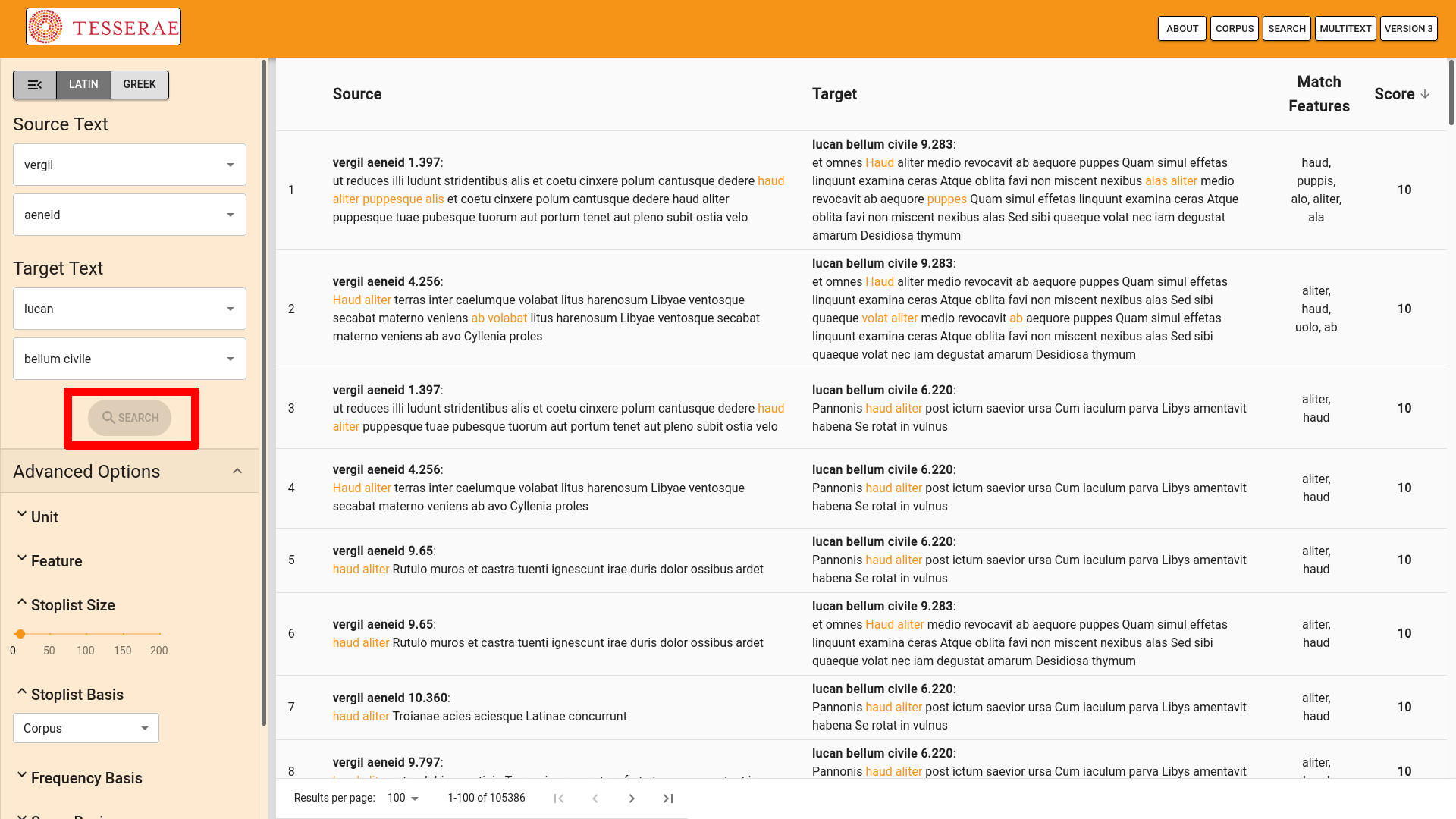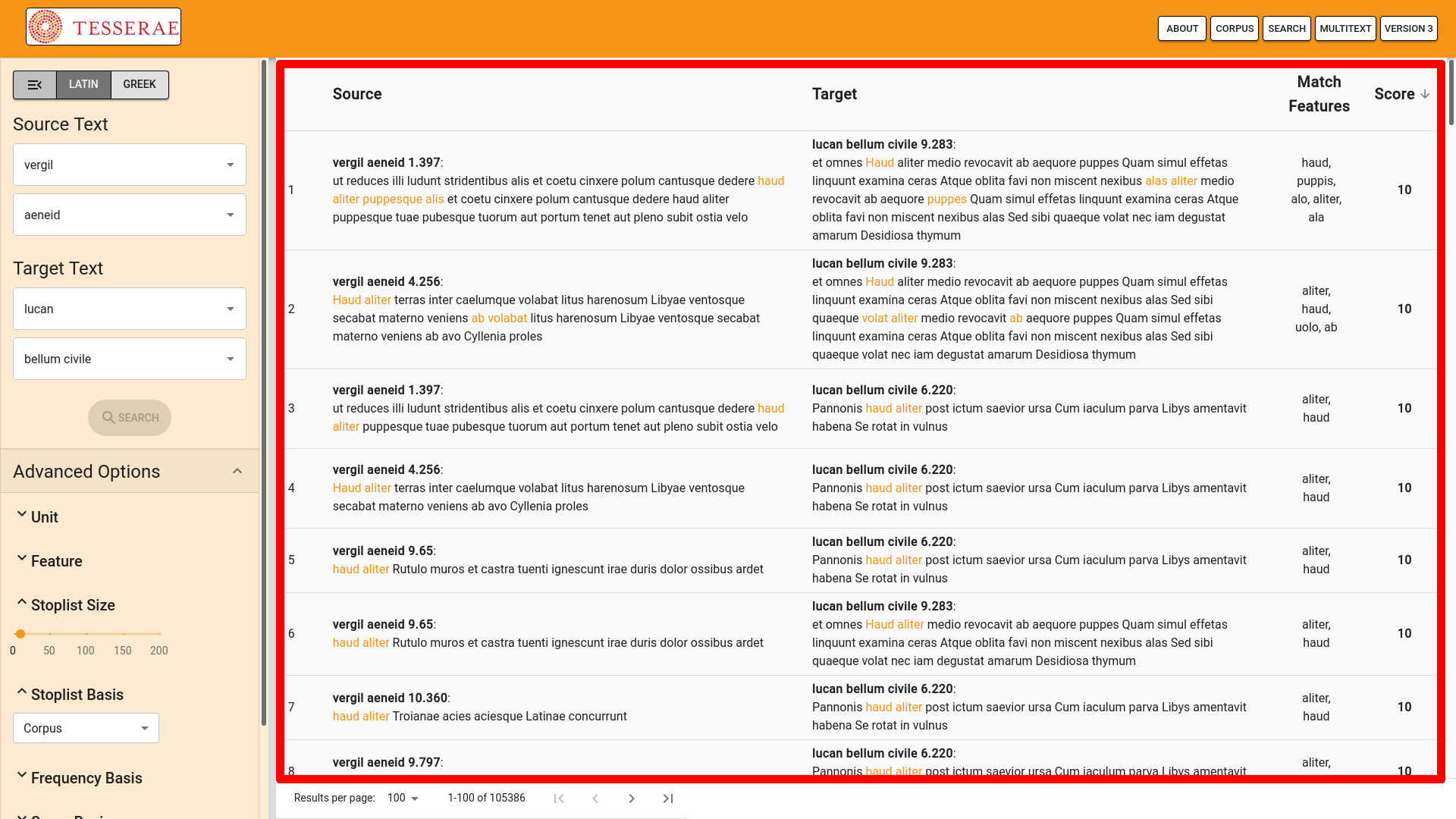Abstract
The Tesserae Intertext Service Application Programming Interface (TIS-API) enhances
the machine-accessibility of the intertext discovery capabilities of the Tesserae
software. Instead of requiring inputs through a human-accessible webpage, the TIS-API
accepts inputs according to a web development standard. Two case studies demonstrate
the contributions of the TIS-API to computer-assisted literary criticism,
particularly in increased software development and maintenance flexibility as well as
in easier integration of Tesserae software into research workflows. Those interested
in integrating the TIS-API into their digital projects can find documentation at https://tesserae.caset.buffalo.edu/docs/api/. For exact implementation
details, the source code is available at https://github.com/tesserae/apitess.
Introduction
The term “intertext” is used to name a passage of text that gives evidence of
one author using another author’s words. Scholarly consensus indicates that
intertexts exist ([
Juvan 2008]
[
Allen 2011] for Latin literature, see [
Edmunds 2001]
[
Coffee 2012a] for Greek literature, see [
Berti 2016]).
While there is great variation in the motivation for the use of an intertext, perhaps
the reuse signals an author’s erudition or enhances the effect of an expression. For
example, when Vergil in his epic
Aeneid describes the
sound of a horse galloping across the fields:
quadrupedante putrem sonitu quatit
ungula campum (Aeneid 8.596).
The horses’ hooves shake the soft-soiled plain with four-footed
thunder.
He is adapting a line from his epic predecessor Ennius:
. . . summo sonitu quatit ungula
terram. (Ennius Annals 8.264)
The horses’ hooves shake the earth with great thunder.
With this recollection, Vergil is reusing available poetic materials, demonstrating
familiarity with his predecessor Ennius, and inviting the reader to compare the
parallel passages.
Various attempts have been made at computer-assisted intertext discovery ([
Lee 2007], [
Mastandrea 2011], [
Büchler 2013], [
Chaudhuri 2015])
[1], but none have made a conscious effort to standardize
machine-accessibility of the intertext discovery process and results. This paper
presents the Tesserae Intertext Service Application Programming Interface (TIS-API),
which specifies the rules of machine-accessibility for the intertext discovery tool
known as “Tesserae”.
We argue that machine-accessibility to Tesserae’s capabilities, as provided by the
TIS-API, is an enhancement to the existing Tesserae software. We first demonstrate
that the TIS-API does, in fact, make Tesserae’s capabilities machine-accessible by
showing how the TIS-API is designed on standard principles in the web development
community, and by walking through an example of how the TIS-API can be used to
conduct a Tesserae search in a machine-accessible way. Two case studies further
explore how the TIS-API enhances the Tesserae software. The first case study
demonstrates how the TIS-API aids collaboration among members of the Tesserae project
team, particularly in the implementation of the new Tesserae website interface. The
second case study demonstrates how someone outside of the Tesserae project team sees
value in the TIS-API for making the software easier to integrate into research
workflows that aid reproducibility in literary criticism research.
Tesserae
The Tesserae Project develops software for discovering intertexts, with particular
focus on the intertexts that appear in ancient Greek and Latin literature [
Coffee 2012b]. The project’s main tool, called Tesserae (
https://tesserae.caset.buffalo.edu/), accomplishes this by analyzing and
comparing two texts for regions of word reuse.
For example, in order to find intertexts between Vergil’s
Aeneid and Lucan’s Bellum Civile, Tesserae goes through both works
line-by-line to find where pairs of words occur in lines from both works. Because the
Aeneid precedes the Bellum Civile in publication, we
can assume that the
Aeneidserved as a source text from
which the later poet could draw upon for poetic raw material. Accordingly, the
results from this Tesserae search can help us find places where Lucan may have
borrowed words from Vergil (see [
Coffee 2012b] for examples).
Given the highly inflected nature of both ancient Greek and Latin, Tesserae also
allows for matching by stem. This allows for finding examples of Lucan reusing
Vergil’s words in different grammatical and morphological forms. It is also useful to
exclude common words, that is stopwords, from Tesserae searches, on the grounds that
the reuse of common words signals not so much Vergil’s influence on Lucan as much as
the common language available to the poets in composing their respective works. In
summary, when Tesserae is given (1) two texts to compare, (2) a manner in which to
compare the words of the texts (i.e., by exact word match or by stem), and (3) a list
of stopwords to ignore, instances of text reuse can be found, which in turn can serve
as evidence of intertexts.
Originally conceived of as a command line tool, the advent of the Tesserae website
interface in 2009 (
https://tesseraev3.caset.buffalo.edu/) made the delivery of its intertext
discovery capabilities much more human-accessible [
Coffee 2012b].
However, this same interface made machine-accessibility difficult for two main
reasons. First, the submission of Tesserae searches relied on user input via web
forms. Second, the results of the Tesserae searches were returned as an HTML webpage.
While these two reasons did not make the Tesserae results impossible to access
automatically, they did present difficulties with the automatic submission of search
queries and the parsing of results because there were no guarantees that the input
forms or the results webpage would remain unchanged. Any tools built on the Tesserae
site looking and performing in exactly one way would most likely fail in the face of
website updates that changed the input forms or the layout of the search results. The
lack of a machine-accessible design created a situation in which Tesserae could be
difficult to integrate with other digital projects, short of installing and hosting a
standalone instance of Tesserae.
The TIS-API eases the burden of integrating Tesserae’s intertext discovery
capabilities into other projects by permitting queries to Tesserae’s database of
texts, submission of Tesserae search requests, and retrieval of search results — all
in a machine-accessible way. The TIS-API was designed, developed, and deployed at the
SUNY University at Buffalo, in collaboration with developers at the University of
Notre Dame, where backend libraries on which the TIS-API relies were developed. The
University of Notre Dame also developed a web frontend powered by the TIS-API,
demonstrating one instance in which the TIS-API eased the burden of integrating
Tesserae’s intertext discovery capabilities into new software. As an important
perspective from outside of the Tesserae Project, a researcher at the Quantitative
Criticism Lab (University of Texas at Austin) has tested and commented on the
TIS-API.
TIS-API Design
Following standard practice for machine-accessible communication across the Internet,
the TIS-API was designed according to the five REpresentational State Transfer (REST)
principles [
Fielding 2000], [
Fielding 2017]. Since the
basic rules for communication over the Internet are already defined by the HyperText
Transfer Protocol (HTTP), the five REST principles provide further guidelines on how
to use HTTP for effective machine-to-machine communication.
The fundamental assumption of the five REST principles is that the only thing a
machine can request from another machine is a resource (Figure 1).
In the original vision of the five REST principles, a resource typically took the
form of a webpage or some multimedia asset, like an image. For Tesserae’s
intertextual discoveries, one resource would be the discoveries themselves — the
results from a Tesserae search. Other resources, such as text information and search
options, aid in the production of those discoveries.
Starting from these basic assumptions about resources, the first REST principle is to
have a name for every resource (Figure 2).
This allows one machine to make a request on a specific resource from another
machine. For example, the name
http://www.buffalo.edu/ refers to the resource that is the main web page
for the University at Buffalo. The TIS-API specifies naming conventions for the
resources necessary to carry out Tesserae searches. For example, the naming
conventions require that “/texts/” be part of the name for resources referring
to texts available in a Tesserae database. More examples of names and the TIS-API
naming conventions will be shown later in the paper.
The second REST principle is that the way one specific request behaves for one
resource is similar to the behavior of the same request on a different resource
(Figure 3).
Within the rules of HTTP, there are various requests that can be made. One common
request is GET, which requests retrieval of the resource. Going back to the
University at Buffalo main web page example, a computer requesting a GET for
http://www.buffalo.edu/ is asking another
computer to retrieve the University at Buffalo main webpage. The TIS-API specifies
that requesting a GET for “<webhost>/texts/” (where “<webhost>”
is replaced with the URL referring to a server on which the TIS-API is installed)
will retrieve information about the texts available in a Tesserae database.
The third REST principle is that modification of a resource is mediated through
instructions, which are called representations (Figure 4).
For the TIS-API, this principle is highlighted particularly in the way Tesserae
searches are submitted. To submit a Tesserae search, a machine must request a POST
(like GET, POST is one of the requests that can be made through HTTP) on the
“<webhost>/parallels/” resource and provide Tesserae search options in
a particular format. The particularly formatted search options would be a
representation to which the third REST principle refers.
The fourth REST principle is that representations are self-descriptive. Admittedly,
the TIS-API does not conform to this principle directly. However, one way in which
the TIS-API adheres to the spirit of this principle is in the search results
resource. Search results resources are defined to contain the search options used to
produce the results available in the resource. In this way, it would be possible to
know exactly what options produced these results (Figure 5). This also enables
caching of results, which can lead to a better user experience in the form of reduced
search times.
The fifth and final REST principle is that application state information should not
be stored; instead, it should be passed as a representation. To unpack the meaning of
this, it is important to consider another assumption about the REST principles: when
one computer communicates with another computer, the two are in a server-client
relationship. The server is the computer that holds the resource that a client wishes
to make a request on. As a result, the client always initiates contact with the
server. Application state refers to a step in some process that the server and client
navigate together.
A common server-client application is online shopping. The first step is for the
client to submit a set of items to purchase; then, the server needs to calculate
various things (like whether the items are in stock, how much the order will cost,
taxes to collect, and other business-related tasks); then, the client needs to
provide authorization to pay for the purchase; finally, the server should notify the
client that the order has been placed and that the purchase has been billed.
According to the fifth REST principle, neither the client nor the server should store
information specifying which step they are on. Rather, the exchange of information
they conduct as part of that process should specify which step they are on.
The TIS-API exhibits compliance with the fifth REST principle in the way it handles
Tesserae search submissions (Figure 6).
For the Tesserae search application, the client first submits a Tesserae search; the
server then needs to run the search and store the results; finally, the client should
be able to access the results. Since Tesserae search may take longer than a user is
willing to wait, it seemed important to design the search application in such a way
that the client would not be stuck waiting for the server to respond with search
results. Designing the application so that the server would first respond to the
client with the resource name for completed search results not only freed the client
from waiting on the server but also made storing application state in either the
server or the client unnecessary. The client can make a request on the completed
search results, and if the server responds that they aren’t ready yet, the client can
wait to make a request later.
The previous points demonstrate that each of the five REST principles were considered
in certain aspects of the TIS-API. While these examples do not describe all the ways
in which the five REST principles were employed in the design of the TIS-API, these
examples should serve to substantiate the claim that the five REST principles were
important considerations during the design of the TIS-API. Because of this, the
TIS-API provides machine-accessibility to Tesserae’s capabilities.
Tesserae Search via the TIS-API
Though claims of machine-accessibility can be made through the REST principles, it
can be more convincing to show machine-accessibility by walking through the process
of submitting a Tesserae search through the TIS-API (see Figure 7 for a high-level
workflow of the process). For those who prefer directly reading the behavior
prescribed by the TIS-API instead of going through this example, the TIS-API
documentation site is available at
https://tesserae.caset.buffalo.edu/docs/api/. For those who want to know
exact details about how the TIS-API was implemented, source code is available at
https://github.com/tesserae/apitess.
Anatomy of a Tesserae Search Query
To start the discussion of how the TIS-API can be used to perform a Tesserae search,
the component parts of a Tesserae search query should be reviewed. Although the
details for the Tesserae search process have already been described [
Forstall 2014], the focus here is to have a simplified but strong
conceptual grasp on the parts involved in a Tesserae search. By understanding what
the building blocks are for defining a search, it will be easier to understand how
each of these blocks are addressed by the TIS-API. The aspects of the Tesserae search
input discussed in this paper are:
- source text
- target text
- type of feature used to find matches
- stopwords
To frame the discussion of these inputs, it will be helpful to state what the
Tesserae search is supposed to do: the objective of Tesserae search is to find
intertexts between two works. Thinking of Tesserae search in this way, it becomes
immediately obvious that two works need to be specified in the input. Because
Tesserae was originally developed as a tool for intertext detection, a relationship
between the two works is assumed: namely, that one work influenced the other. For
this reason, a Tesserae search query is formulated in terms of a “source text”
(i.e., the work that influences the other) and a “target text” (i.e., the work
that was influenced by the other).
Another aspect fundamental to specifying a Tesserae search query is defining what
counts as an intertext. For purposes of the Tesserae search algorithm, an intertext
is defined by the matching of at least two features between two passages, where one
passage comes from the source text, and the other passage comes from the target text.
Thus, it becomes necessary to specify which type of feature to compare when looking
for matching features.
One feature type is the lemma type, which can be thought of as a dictionary headword.
When looking up the definition of a given word in the dictionary, it is sometimes
necessary to change the spelling of the word to find the correct entry. For example,
the definition for the word “love” in “I love to swim” is found in the
dictionary under the lemma “love”. In this example, no spelling change is
necessary to find the lemma. However, the definition for the word “loves” from
“He loves swimming” is also found under the lemma “love”. It is
necessary to remove the final “s” from “loves” in order to find the
lemma.
If lemmata (the plural of lemma) are used to search for intertexts, only passages
that share at least two different lemmata will be considered a potential intertext.
For example, suppose we have the following passages (again):
- I love to swim
- He loves swimming
Note that passage 1 contains the words “love” and “swim”, both of which
also look identical to their lemmata. Passage 2 likewise contains the lemmata
“love” (from “loves”) and “swim” (from “swimming”). From this
information, it can be seen that a Tesserae search searching for intertexts based on
the lemma feature would find that these two passages are a potential intertext.
A final aspect to consider in this simplified conception of the inputs to a Tesserae
search is the matter of stopwords. Often, there are features we believe will be
unimportant in determining whether one passage refers to another. For example, we may
find common words like articles and prepositions to be irrelevant. In this case, we
would like a Tesserae search to ignore passages that match only because of articles
and prepositions. To specify features that we think are not interesting, we can use a
stopwords list to prevent those features from being counted when determining whether
two passages are a potential intertext.
Knowing now that a source text, a target text, a feature definition, and a stopwords
list are important options to specify in a Tesserae search, it is clear that these
options will need to be specified to the TIS-API when submitting a Tesserae search
query.
API Concepts
Before discussing how to use the TIS-API to perform Tesserae search, some terminology
and conventions should be noted. First, the meaning of “TIS-API” should be more
carefully stated. The TIS-API, in its strictest sense, is a set of rules that defines
server behavior in response to client requests. An implementation of the TIS-API,
therefore, is code that, when run, behaves in accordance with the rules that were
defined. When this code is running, we can say that a computer is “running an instance of the TIS-API.” Since the code allows a
computer to follow the rules of the TIS-API and since the deployed software exhibits
the behaviors defined by the rules of the TIS-API, the use of “TIS-API” can slip from
its strict sense into a more inclusive (and therefore ambiguous) sense that may
denote either the rules, the code, or the deployed software.
The angle brackets (“<,”
“>”) convention used in resource names should also be explained explicitly.
Just as earlier in the paper, the angle brackets (“<,”
“>”) denote a placeholder; the word(s) within the angle brackets hint at what
should replace this placeholder. For example, as seen earlier,
“<webhost>/texts/” specifies a name for interacting with text
resources. However, the name does not literally contain “<webhost>”;
rather, “<webhost>” should be replaced with an identifier to a running
instance of the TIS-API. For example, if
https://tesserae.caset.buffalo.edu/api is the URL to a running instance of
the TIS-API,
https://tesserae.caset.buffalo.edu/api/texts/ (note that “/texts/” has
been added to the URL) is the name referring to the text resources available in that
instance.
Finally, the term “endpoint” should be defined. Note that the initial part of
the URL is largely irrelevant to the defined behavior for the TIS-API. In other
words, whether
https://tesserae.caset.buffalo.edu/api or
https://www.tis-api.com is used to work
with texts, the TIS-API will respond in a similar manner — and it would behave
exactly the same if both web hosts had the same text information in their respective
databases. Therefore, the part of the name that distinguishes behavior is what comes
after the web host’s identifier. These distinguishing patterns that come at the end
of the URL are known as “endpoints.” By convention, these endpoints are referred
to not by their full URL; rather, they are referred to by the portion of the URL that
comes after the web host’s URL. For example, “/texts/” is the TIS-API endpoint
that deals with texts.
Using the TIS-API to Run a Tesserae Search
With a clear picture of Tesserae search options as well as the vocabulary used to
express APIs, it is possible to consider how the TIS-API can be used to build and
submit a Tesserae search query. The first endpoint to consider is “/parallels/”,
which accepts Tesserae search requests. By performing a POST request on the
“/parallels/” endpoint and providing the Tesserae search options in a
particular machine-readable format, a Tesserae search query can be submitted. Exact
details on this particular machine-readable format can be found by consulting the
documentation; for purposes of this paper, it is sufficient to know that the
“/parallels/” endpoint accepts Tesserae search query submissions.
Ignoring the specifics of the Tesserae search query submission format for the
“/parallels/” endpoint, earlier discussion has shown that a source text, a
target text, a feature to search by, and a stopwords list must be specified. The
TIS-API can be useful in choosing these options.
Since Tesserae can perform intertext discoveries only between texts already in its
database, we can only reference a source text and a target text already in the
Tesserae database when submitting a Tesserae search. How does the TIS-API provide
access to information about texts in the Tesserae database? As mentioned earlier,
text information can be obtained at the “/texts/” endpoint. Again, there are
specific details about the “/texts/” endpoint that may be useful (such as
querying the Tesserae database for texts written by a particular author) which can be
found by consulting the documentation. But for purposes of this paper, it is
sufficient to know that the “/texts/” endpoint can be used to discover what
texts are available to be used as a source or target text. From the information
returned by performing a GET request on the “/texts/” endpoint, identification
codes used by the database to refer to specific texts can be obtained. These
identifiers can specify a source and a target text in the information submitted in a
POST to “/parallels/”.
Although the TIS-API does not specify a convenient endpoint for determining which
search features can be specified, the documentation does specify valid options.
Furthermore, the TIS-API defines that when an invalid option is given, the response
will include information indicating invalidity of the request.
The TIS-API, however, does have a “/stopwords/” endpoint that can be useful in
choosing a stopwords list. Recall that stopwords lists are often composed of items
that appear most frequently in the language. Given the appropriate information (as
defined in the documentation), the “/stopwords/” endpoint consults the Tesserae
database and returns the most frequently appearing features (Figure 8).
In other words, the “/stopwords/” endpoint can be used to collect the top N most
frequently appearing features, where N is a number that can be specified. That list
can be used as the stopwords list given to “/parallels/” when submitting a
Tesserae search query.
It has been shown that the TIS-API provides the “/parallels/” endpoint for
submitting a Tesserae search query, as well as the “/texts/” and
“/stopwords/” endpoints to aid in choosing Tesserae search options. To
retrieve search results, the TIS-API specifies the “/parallels/<uuid>/”
endpoint, where “<uuid>” is replaced by a search submission identifier
(“UUID” is an acronym for “Universally Unique IDentifier”, which refers
to a string of letters and numbers used to identify something). The identifier for a
particular search can be found in the response data given by the “/parallels/”
endpoint on a successful query submission. In particular, a URL that ends in
“/parallels/<uuid>/” will be specified. In other words, a successful
Tesserae search submission will provide the URL to retrieve the search results.
Importantly, that URL is transmitted in a standard, machine-readable way.
For search queries that involve very small texts, going directly to the URL as soon
as the response from “/parallels/” comes back may permit retrieving the search
results immediately. However, when longer texts are chosen, Tesserae search may take
more time to complete. In that case, results would not immediately appear. Instead,
requesting a GET at the result URL would yield a response indicating that the
resource is not available. To ensure that the search has been submitted, the
“/parallels/<uuid>/status/” endpoint, which retrieves status
information on the search submission (such as whether the search is in process or if
it failed), could be used. When the status indicates that the search is complete, it
would be possible to go to the results URL and find the search results.
Case Study: Running Search on the New Tesserae Website
Having seen a theoretical use case for the TIS-API, it seems worthwhile to consider a
practical use case for the TIS-API as well. To this end, we present the new Tesserae
website, which is available at
https://tesserae.caset.buffalo.edu/ (Figure 9 shows what the website looks
like at the time of writing when displaying results). This example demonstrates how
the TIS-API, though designed for machine-accessibility, can still be used to simulate
the traditional human-accessible experience that Tesserae has offered and that its
user base in classics scholarship (of widely varying technical comfort) has become
familiar with.
In order to perform a Tesserae search, the user first needs to choose source and
target texts. The new website displays the source and target text options in dropdown
menus, found in the top left part of the interface (see Figure 10). Behind the
scenes, the website uses the “/texts/” endpoint to find what texts are available for
comparison from the TIS-API. It then populates the dropdown lists with the
information received from the “/texts/” endpoint. The user can then select source and
target texts with these dropdown menus. In the example image (Figure [uiscreenshot]),
the user has selected Vergil’sAeneidas the source text
and Lucan’s Bellum Civile as the target text.
The user might also wish to have stopwords for the Tesserae search. On the new
website, the number of stopwords to be used can be specified under the “Advanced
Options” (see Figure 12). Behind the scenes, the website uses the parameters
specified under “Advanced Options” to calculate a stopwords list using the
“/stopwords/” endpoint. In the example image (Figure 13), the user has left
the slider bar under “Stoplist Size” at the default of 10 stopwords. The example
image further shows that the stopwords will be calculated based on the corpus
available to the TIS-API, as shown by the selection under “Stoplist Basis”.
To submit the Tesserae search for processing, the user simply hits the “SEARCH”
button (see Figure 12). This action causes the website to submit the search
parameters to the “/parallels/” endpoint. Once the search is complete, the
website automatically calls on the “/parallels/<uuid>/” endpoint to
retrieve the results of the search and displays those results on the main part of the
interface (see Figure 13).
One tangential benefit of defining the new website’s functionality in terms of the
TIS-API was development flexibility. Because the TIS-API defines expected behavior,
the website developer could work on the website at the same time that the API
developer was implementing the expected behavior. This allowed for important feedback
informed by the website developer’s user experience. That feedback resulted in
additional behaviors (e.g., paging of the search results, more detailed search status
information) that improved the API and website together. As the two efforts came
together for deployment of the new Tesserae website, the integration of the website
with the TIS-API implementation required relatively little work (deployment itself,
along with making sure that the user interface looked right, took most of the
development time). This demonstrates the utility of the TIS-API internal to the
Tesserae Project. Other digital humanities developers may want to consider this
benefit when deciding whether they too can afford to improve their software’s ability
to integrate with other software.
Case Study: Harnessing the TIS-API for Research
While the new Tesserae website demonstrates the advantages of the TIS-API for members
of the Tesserae Project, it is also important to establish the advantages conferred
to researchers not directly affiliated with the project. This section describes one
such researcher’s experience with the TIS-API.
For writing his 2017 article “Measuring and Mapping Intergeneric
Allusion using Tesserae” for a special issue of the Journal of Data Mining
and Digital Humanities on Computer-Aided Processing of Intertextuality in Ancient
Languages [
Burns 2017], one of the co-authors of this article found
himself in the position of downloading the results of multiple Tesserae web searches
in order to analyze not just an intertextual comparison of two authors, but rather an
intertextual comparison of one author (the Latin epic poet Lucan) against several
authors representative of a specific genre (the Latin love elegists Propertius,
Tibullus, and Ovid). The searches had to be conducted individually and care needed to
be taken to ensure that each search used the same parameters, including stopword
lists and cutoff scores, among other settings. Moreover, the author needed to be sure
that this consistency in parameter selection could be maintained between sessions,
with sometimes weeks or even months passing between searches. At the time, these
factors were documented by the author in research notes, but from testing the
TIS-API, it is clear how this process could have been improved had the new set-up
been available: a similar paper written now could document the exact TIS-API calls
for all of the author-to-author comparisons in a script with parameters specified
upfront as constants.
This enhancement to the research process made possible through the TIS-API could be
seen as a variation on software development’s DRY — don’t repeat yourself — principle
[
Hunt 2000]. In programming, DRY argues for a reduction of duplicate
code to increase writing efficiency, reduce opportunities for errors to be
introduced, and decrease maintenance costs. The TIS-API allows for analogous benefits
in a research context: searches can be formalized and then run and rerun without
duplicative effort. To paraphrase Andy Hunt and Dave Thomas’s oft-cited definition of
the DRY principle, the TIS-API makes it possible for every Tesserae search to “have a single, unambiguous, authoritative representation”
[
Hunt 2000, 27] within a study.
Accordingly, code-based calls to the TIS-API should be considered now a best practice
for researchers needing to aggregate the results of multiple Tesserae searches, as
for example papers such as [
Bernstein 2015]. That said, even with
respect to research making use of even a single Tesserae search, the ability to
document the request in the form of an API request is valuable. This is because, no
matter the number of searches, being able to document explicitly decisions made and
actions taken in the course of gathering data plays an important role in making that
research reproducible. In other words, code-based calls to the TIS-API improve
researchers’ experience by making decisions explicitly documented at the time of
data-gathering, rather than as an afterthought. It has been argued that researchers
should aim for well-documented and reproducible workflows as part of a critical
digital humanities [
Dobson 2019]. It can also be argued that academic
developers can support researchers in reaching this goal by making it easier to
incorporate their software tools into research workflows. The TIS-API is a move in
this direction.
One final point about using Tesserae searches in research workflows: at present,
running, say, dozens or hundreds of Tesserae searches using the web form could be
seen as a labor-intensive proposition, enough so as to be a disincentive to exploring
research questions demanding this volume of web-form entry. Accessing the TIS-API
through a script, on the other hand, greatly improves the researcher’s experience by
reducing the labor of specifying Tesserae searches, which in turn reduces the risk of
inconsistent querying and related errors that add more labor in data checking and
correction or even having to rerun completed but unusable searches. With this in
mind, one can imagine that availability of the TIS-API, by reducing the difficulty of
collecting and collating multiple searches, will encourage more large-scale
Tesserae-based studies.
Future Work
For all of the benefits made possible through the TIS-API, we recognize that the API
could be improved. One improvement in particular we are considering is a way to
document which version of the software produced a given set of results. This will be
important as software development continues on Tesserae’s core functionality. While
such development aims to improve Tesserae results, those improvements would come at
the cost of reproducibility. It is possible that the development improvement would
cause results obtained through one set of parameters on a given date to be different
from the results obtained through the same set of parameters on a different date. By
explicitly documenting which version of the Tesserae code produces a given set of
results, reproducibility of results could be guaranteed while also permitting
incremental improvements to Tesserae’s core software.
It will also be interesting to see how the TIS-API serves the growing movement within
digital classics to provide better interoperability between collections and tools
emerging from different projects within the field [
Burns 2019]. Such
cross-project collaborations within digital classics hold much promise for enabling
new modes of inquiry across well-known editions and newly digitized works.
Beyond digital classics, we hope the TIS-API will serve as a helpful point of
comparison for other digital humanities projects. A future in digital humanities
where larger questions can be answered through the aggregation of data from multiple
sources will be more easily realized when individual projects provide an API to make
their data more machine-accessible. The considerations made in the design and
implementation of the TIS-API, including the adoption of REST principles and the
analysis of Tesserae’s intertext discovery process, can serve as inspiration for
other projects as they make decisions on how to design and implement their own
APIs.
Conclusion
The TIS-API enables machine-accessibility of Tesserae intertext discovery
capabilities. Machine-accessibility is achieved by following the software industry
standards known as the REST principles, which encouraged thinking about Tesserae’s
capabilities as resources and considering how to act upon those resources. In
particular, the REST principles are evident in how Tesserae’s texts are made
available, how stopwords are computed from Tesserae’s text collection, and how
Tesserae search is implemented without saving application state either in the client
or the server.
Making Tesserae machine-accessible yields two main benefits. First, it allows for
parallelizing development efforts in the Tesserae software, as evidenced by the
simultaneous development of both the TIS-API implementation and the new Tesserae
website. The second benefit is in the promising possibilities for those not
affiliated with the Tesserae project. Specifically, the ability to document search
procedures exactly should lead to improved scholarly practices in computational
literary criticism. We expect that other digital humanities projects can likewise
reap benefits from upgrading their software with machine-accessibility.
Acknowledgments
This work was made possible by NEH Digital Humanities Advancement Grant
HAA-258767-18. PJB acknowledges the support of the Quantitative Criticism Lab and the
Institute for the Study of the Ancient World while conducting this work.
Works Cited
Allen 2011 Allen, G. Intertextuality. Routledge, London. (2011).
Bernstein 2015 Bernstein, Neil, Kyle Gervais, and
Wei Lin. “Comparative rates of text reuse in classical Latin
hexameter poetry.”
Digital Humanities Quarterly 9.3 (2015).
Burns 2017 Burns, Patrick J. “Measuring and Mapping Intergeneric Allusion in Latin Poetry using
Tesserae.”
Journal of Data Mining and Digital Humanities (2017).
https://jdmdh.episciences.org/3821.
Burns 2019 Burns, Patrick J. “Building a text analysis pipeline for classical languages.” In Digital Classical Philology: Ancient Greek and Latin in the Digital
Revolution. Berlin: De Gruyter (2019). pp. 159–76.
Büchler 2013 Büchler, M. “Informationstechnische Aspekte des Historical Text Re-use (English: Computational
Aspects of Historical Text Re-use).” Ph.D. thesis, Leipzig (2013). See also
http://www.etrap.eu/research/tracer/.
Chaudhuri 2015 Chaudhuri, Pramit, Joseph P.
Dexter, and Jorge A. Bonilla Lopez. “Strings, Triangles, and
Go-betweens: Intertextual Approaches to Silius’ Carthaginian Debates.”
Dictynna. Revue de poétique latine 12 (2015). See also
https://www.qcrit.org/filum.
Coffee 2012a Coffee, N. “Intertextuality in Latin Poetry.”
Oxford Bibliographies in Classics. D. Clayman, (ed).
Oxford University Press, New York (2012).
Coffee 2012b Coffee, N., J.-P. Koenig, S. Poornima,
R. Ossewarde, C. Forstall and S. Jacobson. “Intertextuality in
the Digital Age.”
TAPA 142, no. 2 (2012): 381-419.
Dobson 2019 Dobson, J.E. Critical Digital Humanities: The Search for a Methodology. University of
Illinois Press, Champaign, IL (2019).
Edmunds 2001 Edmunds, L. Intertextuality and the Reading of Roman Poetry. Johns Hopkins University
Press, Baltimore (2001).
Fielding 2000 Fielding, Roy T. “Architectural styles and the design of network-based software
architectures.” Vol. 7. Ph.D. thesis, University of California, Irvine
(2000).
Fielding 2017 Fielding, Roy T., Richard N. Taylor,
Justin R. Erenkrantz, Michael M. Gorlick, Jim Whitehead, Rohit Khare, and Peyman
Oreizy. “Reflections on the REST architectural style and
principled design of the modern web architecture (impact paper award).”
Proceedings of the 2017 11th Joint Meeting on Foundations of
Software Engineering. ACM (2017).
Forstall 2014 Forstall, Christopher, Neil Coffee,
Thomas Buck, Katherine Roache, and Sarah Jacobson. “Modeling the
scholars: Detecting intertextuality through enhanced word-level n-gram
matching.”
Digital Scholarship in the Humanities 30, no. 4 (2014):
503-515. See also
http://tesserae.caset.buffalo.edu/.
Hunt 2000 Hunt, A. and Thomas, D. The Pragmatic Programmer: From Journeyman to Master. Addison-Wesley,
Boston (2000).
Juvan 2008 Juvan, M. “Towards a
History of Intertextuality in Literary and Culture Studies.”
CLCweb: Comparative Literature And Culture 10, no. 3
(2008).
https://doi.org/10.7771/1481-4374.1370.
Lee 2007 Lee, John. “A computational
model of text reuse in ancient literary texts.”
Proceedings of the 45th Annual Meeting of the Association of
Computational Linguistics (2007).
Mastandrea 2011 Mastandrea, Paolo, Massimo Manca,
L. Spinazzè, L. Tessarolo, and F. Boschetti. “Musisque Deoque:
Text Retrieval on Critical Editions.”
Journal for Language Technology and Computational
Linguistics 26 (2011): 129-140. See also
http://mizar.unive.it/mqdq/public/.









